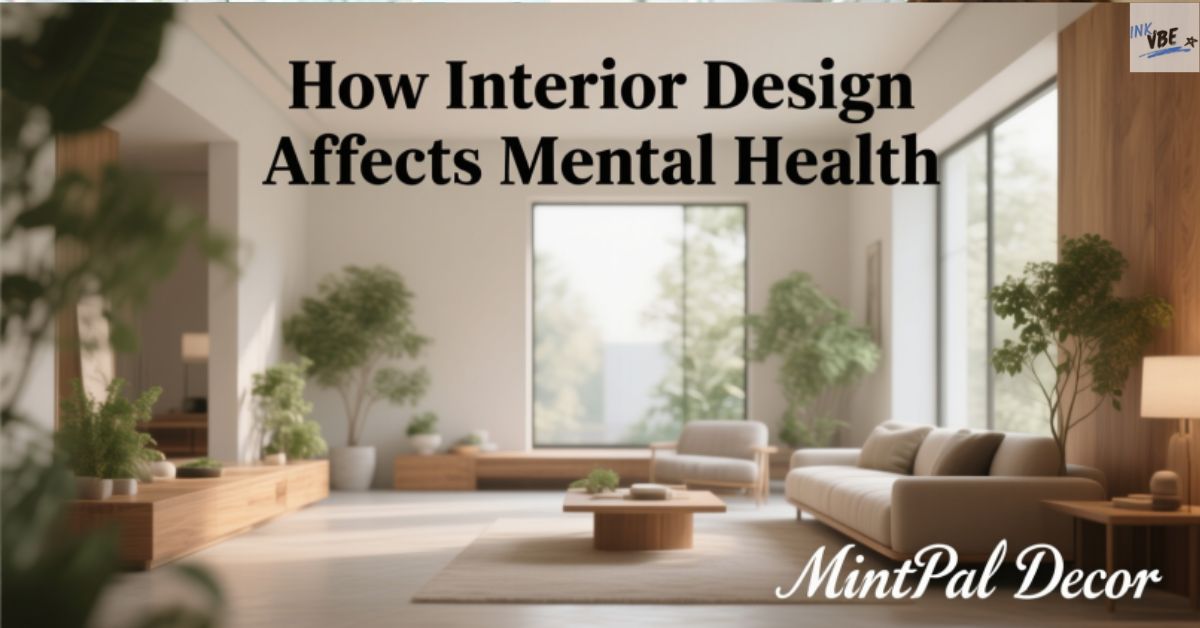Interior design isn’t just about aesthetics—it has a powerful impact on our mental well-being. The spaces we live and work in directly influence our mood, productivity, and stress levels. By carefully selecting colors, arranging furniture, incorporating lighting, and adding personal touches, you can transform your environment into a space that nurtures both your body and mind. This article explores how interior design affects mental health mintpaldecor by examining the psychological effects of design elements and offering practical tips to create mental wellness-friendly spaces.
The Psychology of Interior Design

The Role of Color in Mental Health
Colors are more than just visual elements—they evoke emotional responses that influence how we feel and behave. This is why color psychology plays a significant role in interior design.
- Warm colors like red, orange, and yellow can energize and stimulate conversation. But if overused, they may also induce stress or aggression.
- Cool colors like blue, green, and lavender, on the other hand, are known for their calming effects, making them ideal for bedrooms and relaxation spaces.
- For anxiety reduction, neutral tones and pastel shades are especially effective, as they promote clarity and peace of mind.
You can use color to your advantage by painting walls, selecting furniture, or adding accent pieces with hues that support your desired emotional state.
Influence of Lighting
Lighting impacts much more than visibility—it also influences mood, focus, and natural sleep rhythms.
- Natural light has been proven to boost serotonin levels, which helps alleviate depression and promote happiness. Spaces with large windows or skylights feel bright and inviting.
- If natural light is limited, opt for artificial lighting that mimics daylight. Warm white LED bulbs, for example, create a soft and welcoming atmosphere.
- Task lighting, such as desk lamps, helps improve concentration in workspaces, while dimmable lights allow you to adjust the brightness to suit your needs.
When designing spaces, prioritize layered lighting solutions. Using a mix of ceiling lights, floor lamps, and accent lighting enhances both functionality and comfort.
Space and Layout
The way a space is organized significantly affects mental health.
- Clutter-free spaces provide better mental clarity than chaotic ones. Clutter overwhelms the senses and creates unnecessary stress, while neat, organized spaces encourage relaxation.
- Open floor plans evoke a sense of freedom and connection, while overly cramped or overcrowded layouts can stifle creativity and trigger anxiety.
- Establish functional zones within a single room. For instance, keep workspaces separate from relaxation areas to maintain balance and boundaries.
Thoughtfully arranging furniture and décor helps balance flow and functionality, ensuring your home or workspace feels both efficient and pleasing.
Furniture and Décor Choices
Furniture and décor influence not only the style of a room but also how you feel within it.
- Choosing ergonomic furniture—like supportive office chairs or adjustable desks—reduces physical discomfort, boosting both focus and mood.
- Minimalist designs help reduce mental clutter, while meaningful items such as family photos, artwork, or souvenirs create warmth and emotional connection.
- Avoid overcrowding a space with unnecessary items; instead, carefully curate a collection of purposeful and inspiring pieces.
INFORMATIVE BLOG: DVA Payout for Depression Explained – Types, Eligibility
The Role of Nature in Interior Design

Bringing nature indoors isn’t just a trend—it’s a science-backed way to foster mental health.
- Adding plants improves air quality and creates a calming, refreshing ambiance. Studies show that houseplants can reduce anxiety and fatigue.
- Opting for natural materials such as wood, stone, or bamboo introduces an organic warmth that synthetic materials can’t replicate.
- The biophilic design approach, which seeks to connect occupants more deeply with nature, promotes overall well-being. For instance, a living wall or water feature can transform any area into a tranquil sanctuary.
Practical Tips for Mental Health-Friendly Interior Design
Designing for Specific Needs
Each room in your home serves a unique purpose and should reflect that in its design.
- For relaxation areas like bedrooms, use soft textures, dim lighting, and muted colors to encourage rest.
- Workspaces should promote focus with energizing elements, such as bright colors, organized desks, and motivational artwork.
- Multitasking areas like living rooms benefit from flexible furniture arrangements that adapt to various uses.
Tips for Decluttering and Organizing
Organized spaces reduce mental strain by promoting focus, efficiency, and peace.
- Start by decluttering one room at a time. Donate or recycle items you no longer need.
- Invest in storage solutions like shelves, baskets, and organizers to keep belongings hidden but accessible.
- Regularly tidy up your space to maintain an orderly, calm environment.
Budget-Friendly Mental Wellness Improvements
Creating mental health-friendly spaces doesn’t need a hefty price tag.
- Affordable décor updates like switching out curtains or pillow covers can give a fresh look to tired spaces.
- Upcycling old furniture with paint or new hardware is a sustainable, cost-effective way to transform your space.
- Opt for DIY gardening to cultivate indoor plants affordably, combining creativity and nature.
Examples of Mental Health-Oriented Designs
Consider these real-life inspirations for mental health-focused spaces:
- A home office designed with adjustable lighting, ergonomic furniture, and uplifting wall art to enhance productivity.
- Bedrooms featuring plush bedding, noise-canceling curtains, and soothing scents like lavender for a restful retreat.
- Communal spaces that incorporate cozy seating arrangements, neutral tones, and greenery to foster conversation and relaxation.
The Science Behind It All
Several studies back the link between interior design and well-being. For example, researchers found that individuals exposed to natural lighting experienced a 40% improvement in productivity and a significant reduction in seasonal depression. Similarly, plants in work environments reduced stress by 37% while increasing satisfaction.
Conclusion
Designing your environment intentionally is one of the easiest, most accessible ways to boost mental health. By understanding how interior design affects mental health mintpaldecor, you can create spaces that reduce stress, enhance focus, and promote positivity. Start with small steps—add a plant, rearrange your furniture, or paint a wall in a soothing color—and continue building until your space feels like a personal haven of well-being.
Call to Action
Take a moment to reflect on your current environment. What elements spark joy? What feels stressful? Experiment with the design tips outlined here, and share your results. Together, we can create healthier, more inspiring living spaces for all.
FAQs
What are some small changes I can make to create a calming space?
Start with small updates like changing wall colors to softer shades, adding plants, and installing soft lighting fixtures.
Does interior design affect sleep quality?
Yes, design elements such as blackout curtains, calming colors, and a clutter-free bedroom significantly improve sleep quality.
Are there specific materials that enhance mental health in interior design?
Natural materials like wood, stone, and bamboo create organic, calming environments.
How does biophilic design differ from traditional design?
Biophilic design focuses on integrating natural elements like plants, water features, and sunlight into spaces to connect occupants with nature.
Can interior design improve focus and productivity?
Absolutely. Features like organized layouts, ergonomic furniture, and proper lighting elevate focus and efficiency in workspaces.





